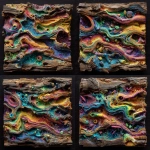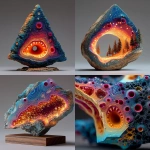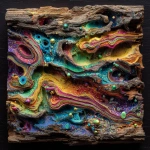Explore the Best AI Image Gallery

Beyond the Brush: How Edge Computing is Reshaping Creative Industries
The creative landscape is constantly evolving, propelled by technological advancements that push the boundaries of artistic expression. While wearable technology has garnered significant attention for its impact on creativity, another force is quietly revolutionizing the industry: edge computing.
Edge computing brings computation and data storage closer to the source of data generation, enabling real-time processing and reduced latency. This paradigm shift holds immense potential for creative applications, empowering artists, designers, and innovators with unprecedented tools and possibilities.
Applications at the Forefront
- Interactive Installations and Immersive Experiences: Edge computing allows for seamless data exchange between sensors, actuators, and real-time rendering engines. This facilitates the creation of interactive art installations that respond to audience presence and actions, blurring the lines between observer and participant.
- Dynamic Content Generation: Imagine an artwork that adapts and evolves based on viewer interaction or environmental factors. Edge computing enables this by processing data from various sources – cameras, microphones, even weather sensors – and dynamically generating content in real time, fostering a truly personalized creative experience.
- Augmented Reality (AR) and Virtual Reality (VR) Enhancements: By reducing latency, edge computing enhances the responsiveness of AR/VR experiences. This is crucial for applications like virtual sculpting or collaborative design projects, where precise interaction and real-time feedback are essential.
- Personalized Creative Tools: Edge computing can empower artists with adaptive tools that learn from their style and preferences. Imagine a digital painting program that anticipates your brushstrokes or a music composition tool that generates melodies based on your emotional input.
Ethical Considerations in the Age of Edge Computing
As with any powerful technology, edge computing raises ethical considerations that must be addressed proactively.
- Data Privacy and Security: Edge computing often involves processing sensitive user data. Robust security measures are crucial to protect this information from breaches and misuse.
- Algorithmic Bias: AI algorithms used in edge computing applications can inherit biases present in the training data. This can lead to unfair or discriminatory outcomes, requiring careful monitoring and mitigation strategies.
- Accessibility and Inclusivity: The benefits of edge computing should be accessible to all individuals, regardless of their technical expertise or physical abilities. Designing inclusive creative tools and experiences is paramount.
Future Trends: Shaping the Creative Landscape
The future of edge computing in the creative industry is brimming with possibilities:
- Increased Interconnectivity: Edge devices will seamlessly communicate and collaborate, enabling the creation of more complex and immersive experiences.
- Democratization of Creative Tools: Edge computing will empower individuals with accessible and affordable tools for artistic expression, fostering a more inclusive creative ecosystem.
- Personalized Creative Journeys: AI-powered edge applications will personalize creative workflows, offering tailored suggestions and guidance based on individual preferences and skills.
As edge computing continues to evolve, its impact on the creative industry will be profound. By embracing this transformative technology responsibly and ethically, we can unlock new frontiers of artistic expression and shape a future where creativity knows no bounds.




](https://images.ai-img.art/thumbnails/150/914cb18c03c97bdba2f290c0ec1573d5792bf399dbad7f484614764eb31f4c2f.webp)



](https://images.ai-img.art/thumbnails/150/ebc95932b25c17607076ed8d2a4bafc85c3371cf3f2d45c35741505fe3c97de1.webp)

](https://images.ai-img.art/thumbnails/150/a31f622763ce0ecb2e76a907e566b81cfcc171e8d9b8b393f27681be24b6ca91.webp)
](https://images.ai-img.art/thumbnails/150/3b65287fef447a6ad61bcb18b5b9d03b6f6f74603ae0e058f81f4b91a3e02f36.webp)













](https://images.ai-img.art/thumbnails/150/7d9de60c58579b921ad140a9e1d752642452d5086b74a27d866e8af04608ed7d.webp)



](https://images.ai-img.art/thumbnails/150/98325fa7102e81df81f1dba6df8df52929b4fa41b058192faf3c77cf94513ff7.webp)





](https://images.ai-img.art/thumbnails/150/ac7218edd6198d49ed8d9853a5890595fc4d2a7a11c2e8a7ee8bcfbc7bfe265e.webp)

](https://images.ai-img.art/thumbnails/150/09314c003088f7174f747fa65105eca599e0842cf69e637ce4c98ebefd3f50ab.webp)










](https://images.ai-img.art/thumbnails/150/769518185300fcbda91b7bbf92b9007bc856379accd52eaf7983f9aec379e88e.webp)
